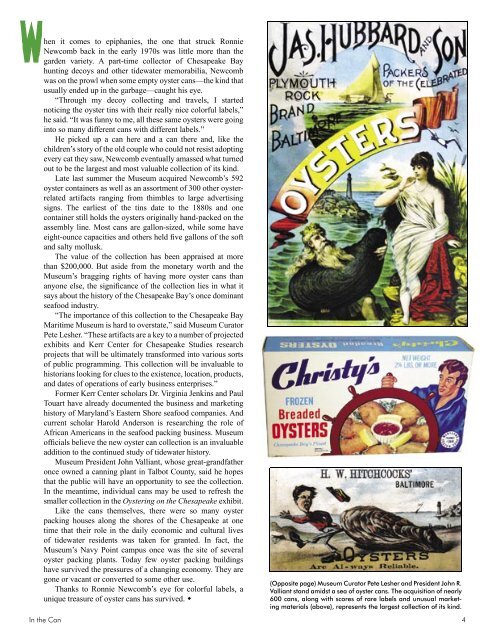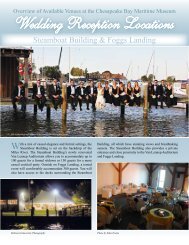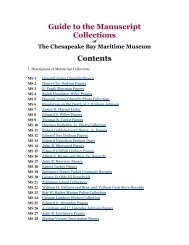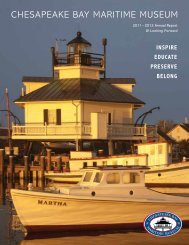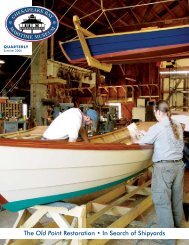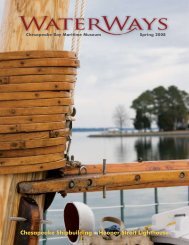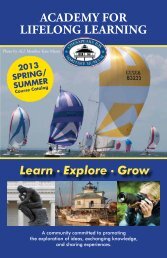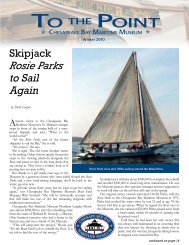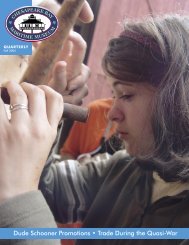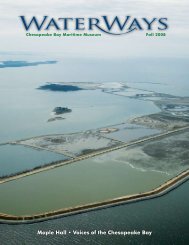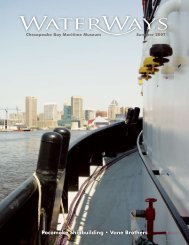Spring 2003 - Chesapeake Bay Maritime Museum
Spring 2003 - Chesapeake Bay Maritime Museum
Spring 2003 - Chesapeake Bay Maritime Museum
You also want an ePaper? Increase the reach of your titles
YUMPU automatically turns print PDFs into web optimized ePapers that Google loves.
When it comes to epiphanies, the one that struck Ronnie<br />
Newcomb back in the early 1970s was little more than the<br />
garden variety. A part-time collector of <strong>Chesapeake</strong> <strong>Bay</strong><br />
hunting decoys and other tidewater memorabilia, Newcomb<br />
was on the prowl when some empty oyster cans—the kind that<br />
usually ended up in the garbage—caught his eye.<br />
“Through my decoy collecting and travels, I started<br />
noticing the oyster tins with their really nice colorful labels,”<br />
he said. “It was funny to me, all these same oysters were going<br />
into so many different cans with different labels.”<br />
He picked up a can here and a can there and, like the<br />
children’s story of the old couple who could not resist adopting<br />
every cat they saw, Newcomb eventually amassed what turned<br />
out to be the largest and most valuable collection of its kind.<br />
Late last summer the <strong>Museum</strong> acquired Newcomb’s 592<br />
oyster containers as well as an assortment of 300 other oysterrelated<br />
artifacts ranging from thimbles to large advertising<br />
signs. The earliest of the tins date to the 1880s and one<br />
container still holds the oysters originally hand-packed on the<br />
assembly line. Most cans are gallon-sized, while some have<br />
eight-ounce capacities and others held five gallons of the soft<br />
and salty mollusk.<br />
The value of the collection has been appraised at more<br />
than $200,000. But aside from the monetary worth and the<br />
<strong>Museum</strong>’s bragging rights of having more oyster cans than<br />
anyone else, the significance of the collection lies in what it<br />
says about the history of the <strong>Chesapeake</strong> <strong>Bay</strong>’s once dominant<br />
seafood industry.<br />
“The importance of this collection to the <strong>Chesapeake</strong> <strong>Bay</strong><br />
<strong>Maritime</strong> <strong>Museum</strong> is hard to overstate,” said <strong>Museum</strong> Curator<br />
Pete Lesher. “These artifacts are a key to a number of projected<br />
exhibits and Kerr Center for <strong>Chesapeake</strong> Studies research<br />
projects that will be ultimately transformed into various sorts<br />
of public programming. This collection will be invaluable to<br />
historians looking for clues to the existence, location, products,<br />
and dates of operations of early business enterprises.”<br />
Former Kerr Center scholars Dr. Virginia Jenkins and Paul<br />
Touart have already documented the business and marketing<br />
history of Maryland’s Eastern Shore seafood companies. And<br />
current scholar Harold Anderson is researching the role of<br />
African Americans in the seafood packing business. <strong>Museum</strong><br />
officials believe the new oyster can collection is an invaluable<br />
addition to the continued study of tidewater history.<br />
<strong>Museum</strong> President John Valliant, whose great-grandfather<br />
once owned a canning plant in Talbot County, said he hopes<br />
that the public will have an opportunity to see the collection.<br />
In the meantime, individual cans may be used to refresh the<br />
smaller collection in the Oystering on the <strong>Chesapeake</strong> exhibit.<br />
Like the cans themselves, there were so many oyster<br />
packing houses along the shores of the <strong>Chesapeake</strong> at one<br />
time that their role in the daily economic and cultural lives<br />
of tidewater residents was taken for granted. In fact, the<br />
<strong>Museum</strong>’s Navy Point campus once was the site of several<br />
oyster packing plants. Today few oyster packing buildings<br />
have survived the pressures of a changing economy. They are<br />
gone or vacant or converted to some other use.<br />
Thanks to Ronnie Newcomb’s eye for colorful labels, a<br />
unique treasure of oyster cans has survived. •<br />
(Opposite page) <strong>Museum</strong> Curator Pete Lesher and President John R.<br />
Valliant stand amidst a sea of oyster cans. The acquisition of nearly<br />
600 cans, along with scores of rare labels and unusual marketing<br />
materials (above), represents the largest collection of its kind.<br />
In the Can 4


